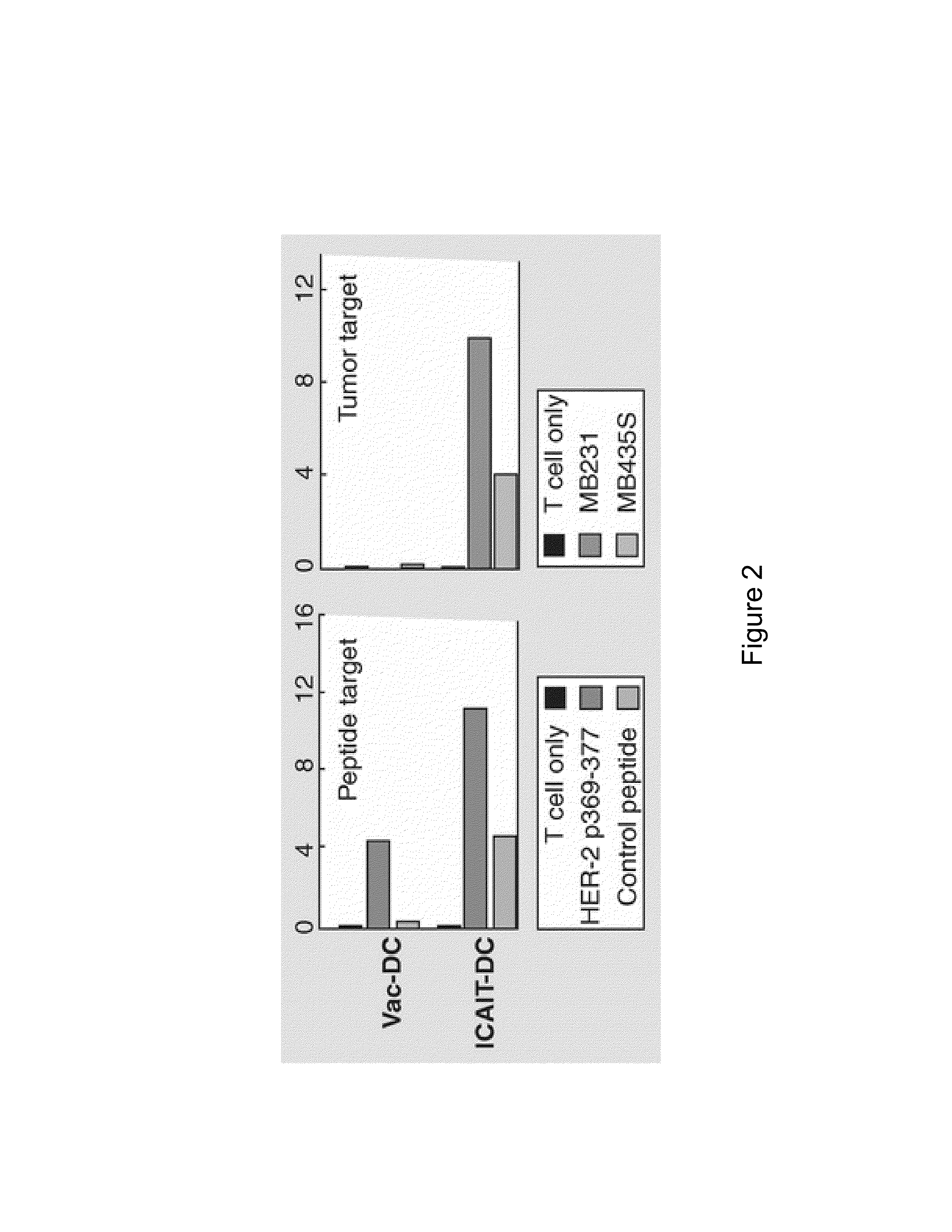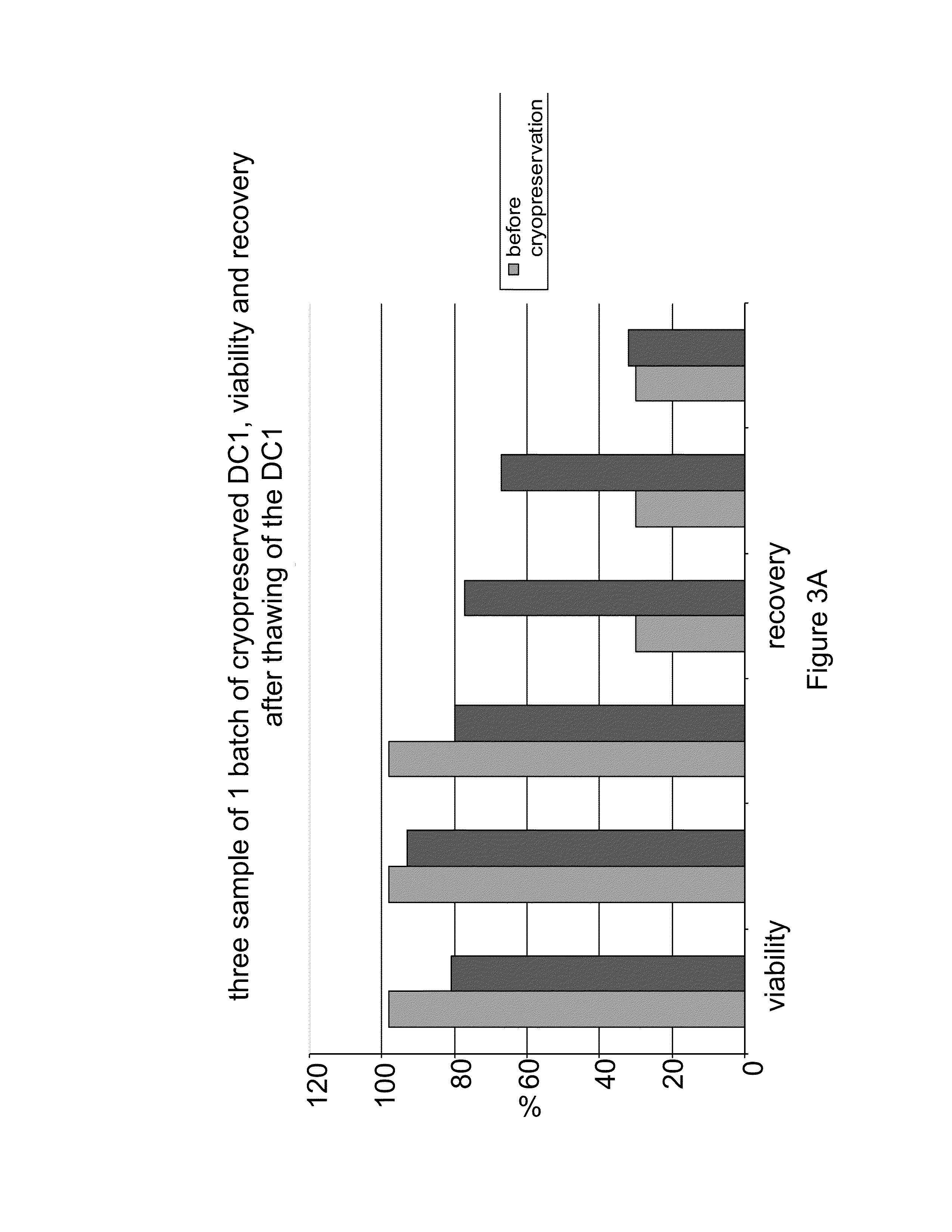System and Method of Preparing and Storing Activated Mature Dendritic Cells
a technology of activated dendritic cells and storage methods, applied in the field of system and method of preparing and storing activated dendritic cells, can solve the problems of limiting the potential therapeutic use of dc, affecting patient survival, and generally disappointing vaccines
- Summary
- Abstract
- Description
- Claims
- Application Information
AI Technical Summary
Benefits of technology
Problems solved by technology
Method used
Image
Examples
example 2
CD4+CD25+ T Cells Inhibit Responder Cell Proliferation in the Presence of Immature but not DC1 Dendritic Cells
[0143]Previously, it was demonstrated that purified CD14+ elutriated monocytes acquire characteristics of activated DC when treated with DC signaling agents (Czerniecki 1997). More recently it was demonstrated that these monocyte-derived tumor antigen-bearing dendritic cells generated using IFN-γ and the TLR-4 agonist LPS (LPS activated DC) promote a targeted immune response in patients with ductal carcinoma in situ (Czerniecki et al., 2007, Cancer Res 67:1842-1852). Prior studies have consistently demonstrated that TLR agonists including LPS are capable of abrogating immunosuppression mediated by CD4+CD25+Foxp3+ T cells (refs). Thus, it is hypothesized that TLR-activated DC may be capable of reversing Treg-mediated immunosuppression.
[0144]To test this hypothesis, the experiments were designed to compare the capacity of human CD4+CD25+ T cells to inhibit the proliferation of...
example 3
Inhibition of Treg Function by DC1 Dendritic Cells Results from a Soluble Factor but is IL-6 and IL-12 Independent
[0146]Experiments were designed to characterize the mechanism by which the DC1 population inhibits Treg-mediated suppression. To determine whether DC1 dendritic cells inhibit Treg-mediated suppression by inducing apoptosis in the regulatory T cell complement, sorted CD4+CD25+ T cells were co-cultured with iDC and LPS activated DC and compared the expression of the apoptotic markers Annexin-V and 7-AAD after 24 hours. Day 1 was chosen as the time point with the presumption that proliferative differences noted at day 5 would result from apoptotic events far earlier. After 24 hours of culture, as depicted in FIG. 7A (p>0.2 for the Annexin+ / 7-AAD+ and Annexin− / 7AAD− groups), the expression of both Annexin-V and 7-AAD was similar amongst Tregs co-cultured with either dendritic cell population. These data suggest that the LPS activated DC population does not significantly alte...
example 4
Suppressor CD4+CD25+ T Cells Upregulate T-Bet, Down Regulate FoxP3, and Secrete Effector Cytokines in the Presence of DC1 Dendritic Cells
[0151]Recent studies in several experimental models have shown that dendritic cells of various phenotypes are capable of converting regulatory T cells into antigen-specific autoimmune effectors (Baban et al., 2009, J Immunol 183:2475-2483, 18; Radhakrishnan et al., 2008, J Immunol 181:3137-3147). Mechanistically, this finding is characterized by down regulation of the transcriptional regulator FoxP3 and can involve upregulation of effector cytokines. Most consistently noted is conversion of Tregs into IL-17-producing effector cells that likely mediate Th17 immunity (Baban et al., 2009, J Immunol 183:2475-2483, 18; Radhakrishnan et al., 2008, J Immunol 181:3137-3147; Beriou et al., 2009, Blood 113:4240-4249). To determine whether the break in suppression reflected simple deactivation of regulatory T cells or their conversion into effector cells that...
PUM
| Property | Measurement | Unit |
|---|---|---|
| Temperature | aaaaa | aaaaa |
| Fraction | aaaaa | aaaaa |
| Fraction | aaaaa | aaaaa |
Abstract
Description
Claims
Application Information
 Login to View More
Login to View More - R&D
- Intellectual Property
- Life Sciences
- Materials
- Tech Scout
- Unparalleled Data Quality
- Higher Quality Content
- 60% Fewer Hallucinations
Browse by: Latest US Patents, China's latest patents, Technical Efficacy Thesaurus, Application Domain, Technology Topic, Popular Technical Reports.
© 2025 PatSnap. All rights reserved.Legal|Privacy policy|Modern Slavery Act Transparency Statement|Sitemap|About US| Contact US: help@patsnap.com



